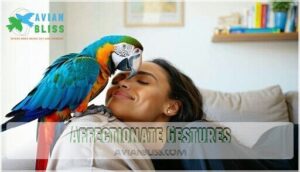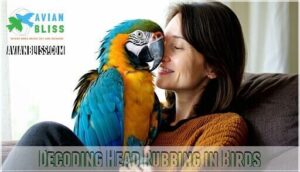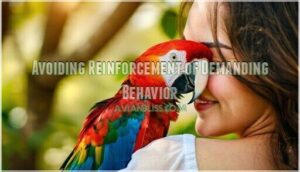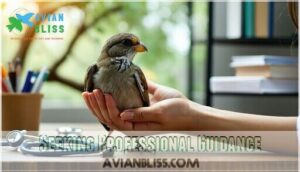This site is supported by our readers. We may earn a commission, at no cost to you, if you purchase through links.
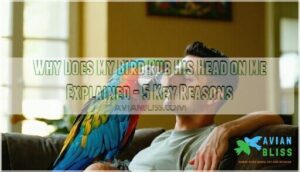
This behavior mimics how birds preen each other in the wild – they’re basically treating you like a beloved flock mate.
Your feathered friend is seeking comfort, expressing love, and possibly asking for some gentle head scratches.
It’s their way of saying "you’re part of my family."
Sometimes it’s also a request for help with those hard-to-reach pin feathers that can be itchy.
However, excessive head rubbing might signal underlying health issues like mites or infections that need attention.
Understanding these subtle bird behaviors reveals fascinating insights about their emotional world and physical needs.
Table Of Contents
- Key Takeaways
- Reasons for Head Rubbing Behavior
- Understanding The Meaning of Head Rubbing
- Decoding Head Rubbing in Birds
- Addressing Concerns and Misconceptions
- Promoting Healthy Interactions
- Seeking Professional Guidance
- Frequently Asked Questions (FAQs)
- How do you tell if your bird is bonded to you?
- Why is my bird rubbing himself on me?
- Are there any specific areas on a bird’s head that they prefer to rub against?
- How often should birds rub heads normally?
- Can multiple birds rub heads together?
- What surfaces do birds prefer for rubbing?
- Do wild birds exhibit head rubbing behavior?
- When should I discourage head rubbing completely?
- Conclusion
Key Takeaways
- Your bird’s head rubbing shows deep trust and affection – when your feathered friend rubs their head on you, they’re treating you like a beloved flock mate and expressing genuine love through this intimate bonding behavior.
- It’s a natural request for attention and comfort – your bird uses head rubbing to communicate their need for interaction, gentle head scratches, or help with itchy pin feathers they can’t reach themselves.
- Watch for excessive rubbing that signals health issues – while normal head rubbing is sweet, frantic or persistent rubbing might indicate mites, skin infections, or beak problems that need veterinary attention.
- You can strengthen your bond by responding appropriately – acknowledge their affection with gentle petting and soft words, but don’t reward demanding behavior by giving attention every time they rub on you.
Reasons for Head Rubbing Behavior
When your bird rubs his head on you, he’s communicating through instinctive behaviors that serve multiple purposes in his social world.
This tactile interaction represents a complex mix of attention-seeking, affection display, and potential health-related responses that require careful observation to interpret correctly.
Seeking Attention
When does your bird typically rub their head on you? It’s usually when they’re craving your undivided attention. This attention-seeking behavior serves as a clear social cue that your feathered friend wants interaction.
Birds naturally communicate through physical gestures since they can’t simply ask for what they need. Head rubbing becomes their way of saying "Hey, notice me!" These bird whispers signal their social needs, especially when you’re busy with other tasks.
Smart owner responses include acknowledging this bird affection sign with gentle petting or vocal praise, satisfying their fundamental need for connection. Understanding the role of visual error correction can also provide insights into your bird’s behavior and social interactions, highlighting the importance of social cues and bird affection in their daily life, and helping you recognize their need for interaction.
Expressing Affection
This loving behavior mirrors how birds express care in the wild.
When your feathered friend rubs their head against you, they’re displaying genuine affection and strengthening your bond. It’s their way of saying "you’re part of my flock."
Here are three key affection signs to recognize:
- Gentle head pressing – Your bird leans into you with soft, deliberate movements, showing trust and emotional connection
- Repeated contact – They return to rub against you multiple times, demonstrating their desire for closeness and bonding
- Relaxed body language – Wings stay close, eyes appear calm, indicating they feel safe expressing love displays
This parrot head rubbing creates lasting emotional connections through trust building behaviors that strengthen your relationship.
Addressing Health Issues
When persistent head rubbing becomes excessive, it’s often your bird’s way of signaling underlying health issues that need attention.
Mite infestations, particularly around the beak and eyes, can cause intense itching that drives frantic rubbing behavior. Skin conditions like bacterial infections or feather issues may also trigger this response.
Beak problems, including overgrowth or injury, can make birds seek relief through constant contact. If you notice sudden changes in rubbing patterns or intensity, don’t wait—veterinary care is essential.
Bird health concerns escalate quickly, and early intervention prevents serious illness. Your avian vet can identify specific health risks and provide targeted treatment for ideal bird health.
Understanding The Meaning of Head Rubbing
When your bird rubs his head on you, he’s communicating specific emotional and physical needs that require your understanding.
This behavior serves as a primary form of non-verbal communication, expressing everything from affection and trust to potential health concerns that need attention.
Affectionate Gestures
Your bird’s head rubbing represents genuine affection and trust-building behavior.
This intimate gesture mimics natural social bonding patterns, showing your feathered companion feels safe and connected.
When your bird engages in head nuzzling or beak rubbing against you, it’s their way of saying "I love you."
These bird affection signs include gentle feather petting motions and face rubbing that strengthen your bond.
Bird cuddling through head contact creates emotional security, demonstrating parrot head nuzzling as a primary communication method for expressing care and attachment, which is a sign of genuine affection and helps in trust-building behavior, and ultimately leads to emotional security.
Emotional Bonding
That tender head rubbing represents your bird’s deepest emotional connection with you.
This heartfelt interaction demonstrates profound trust building through bird social behavior that mirrors wild bonding techniques.
When your feathered friend engages in this bird bonding behavior, they’re creating social attachment that strengthens your relationship.
These parrot affection signs show genuine bird affection signs through instinctual communication.
Your bird’s rubbing head behavior signals contentment and security, making these moments precious opportunities for emotional connection that enhance your bond naturally, which is a result of profound trust and social attachment.
Potential Health Concerns
While emotional bonding creates beautiful connections, excessive head rubbing might signal underlying health issues.
Frequent scratching could indicate mite infestations, skin irritations, or feather problems affecting your bird’s comfort.
Watch for persistent rubbing around the beak area, as beak issues often cause discomfort.
If you notice changes in your bird’s normal head-rubbing patterns, schedule health exams with an avian veterinarian.
Early detection of bird health concerns prevents serious complications from developing, making it crucial to monitor your bird’s behavior and seek professional advice when necessary, focusing on overall bird’s comfort.
Decoding Head Rubbing in Birds
When your bird rubs his head on you, he’s communicating specific needs and emotions that require proper interpretation.
This behavior serves as a primary form of non-verbal communication, expressing everything from seeking comfort to signaling deep trust in your relationship.
Communication of Needs
Your bird’s head rubbing acts as their primary communication tool, sending clear emotional cues and social signals about their immediate needs.
This bird language represents sophisticated need expression – whether they’re requesting attention, food, or physical comfort.
When your bird rubs their face on you, they’re making specific care requests through this affection display.
Think of it as their way of saying "I need something from you right now" to convey their immediate needs.
Understanding these bird communication patterns helps you respond appropriately to their head rubbing meaning.
Seeking Comfort and Security
When your feathered companion seeks comfort and security, bird head rubbing becomes their go-to stress relief mechanism.
This comfort seeking behavior represents deep emotional support needs, similar to how children clutch favorite blankets during uncertainty.
Your bird’s trust building efforts through face rubbing demonstrate their security needs being met through social bonding with you.
Understanding these comfort patterns helps you recognize when your bird requires extra reassurance during environmental changes or stressful situations.
Signaling Trust and Contentment
Your bird’s head rubbing reveals deep trust signals and contentment behaviors that strengthen your bond.
This parrot love sign shows your feathered friend feels safe and secure in your presence.
When your bird shows affection through bird head rubbing or bird rubbing face on owner, it’s communicating emotional connections and social comfort.
These bonding mechanisms indicate your bird sees you as part of their flock, creating meaningful bird social bonding experiences together.
Understanding trust building behaviors is essential to fostering a strong relationship with your bird.
Addressing Concerns and Misconceptions
You’ll encounter some head rubbing situations that raise questions about what’s normal versus concerning behavior in your feathered friend.
Understanding these distinctions helps you respond appropriately and avoid accidentally encouraging problematic patterns through well-meaning but misguided reactions, which is crucial for maintaining a healthy relationship with your feathered friend.
Differentiating From Mating Behavior
Your bird’s head rubbing isn’t always about romance. Distinguishing between affectionate bonding and mating behavior requires careful observation of accompanying signals.
Key differences to watch for:
- Mating signs include regurgitation, crouching postures, and intense vocalizations
- Courtship behaviors involve tail fanning, wing spreading, and ritualistic displays
- Trust signals appear as gentle, relaxed movements without hormonal intensity
- Bonding types vary – affectionate rubbing lacks the urgency of reproductive behavior
- Pair bonding attempts show seasonal patterns and territorial aggression
Simple bird nuzzling behavior and bird social bonding occur year-round, while true courtship emerges during breeding seasons with distinct behavioral clusters.
Age-Appropriate Actions
Understanding your bird’s developmental stage helps you respond appropriately to their head rubbing behavior.
Young birds display different social needs than mature adults, requiring customized approaches for healthy bonding.
| Age Stage | Typical Behavior | Appropriate Response |
|---|---|---|
| Juvenile | Seeks comfort through contact | Gentle petting, soft voice |
| Adolescent | Tests boundaries, increased rubbing | Consistent limits, redirect energy |
| Adult | Established bonding patterns | Maintain routine interactions |
Juvenile Behavior in young birds mirrors their natural Social Learning process.
Adolescent Development often intensifies bird rubbing head frequency as hormones shift.
Mature Interactions require understanding your bird’s love language through consistent socialization opportunities.
Environmental Enrichment supports healthy development across all ages, while recognizing how age and gender influence bird behavior patterns.
Avoiding Reinforcement of Demanding Behavior
Setting boundaries with your bird rubbing head behavior prevents demanding patterns from taking root.
When you consistently give in to attention-seeking displays, you’re accidentally teaching your bird that persistence pays off.
This creates a cycle where bird behavior becomes increasingly demanding.
Effective boundary setting requires these key strategies:
- Establish consistent response patterns – Don’t reward excessive head rubbing with immediate attention
- Use positive reinforcement timing – Reward calm behavior instead of demanding actions
- Implement structured interaction schedules – Provide attention on your terms, not theirs
- Apply behavior modification techniques – Redirect attention-seeking into appropriate activities
- Create alternative reward systems – Offer enrichment activities that satisfy social needs
Remember, you’re not being mean by setting limits.
Think of it like teaching a toddler patience – consistency now prevents bigger behavioral challenges later.
Promoting Healthy Interactions
You can strengthen your bond with your bird by understanding when head rubbing signals a need for interaction and responding appropriately.
Creating positive experiences through proper attention, alternative bonding methods, and enriching activities helps satisfy your bird’s social needs while promoting healthy behavioral patterns.
Providing Proper Attention and Affection
Quality time with your bird builds trust through consistent Bird Socialization.
Recognize their Attention Signals – head tilts, chirping, or approaching you.
Different birds show various Affection Types, from gentle nuzzling to playful nibbling.
Effective Bonding Techniques include talking softly, offering treats, and respecting their space.
When your bird rubbing face occurs, respond with gentle head scratches.
These parrot love signs indicate contentment.
Understanding your feathered friend affection helps decode their bird love language.
Simple Interaction Methods like reading aloud or humming create positive associations.
Head rubbing becomes their way of saying "I love you too.
Providing the right bird nutrition supplements can also strengthen your bond with your bird.
Offering Alternative Forms of Bonding
Beyond head rubbing, you can build stronger bonds through playtime activities like teaching tricks or playing peek-a-boo.
Social interactions during quiet moments create deeper connections than constant physical contact. Try gentle petting sessions on your bird’s back or sharing spaces while reading.
These bonding alternatives reduce demanding bird rubbing behaviors while satisfying your pet’s need for affection and attention through varied experiences.
Understanding bird communication methods, such as vocal learning processes, can also help you better interact with your bird to foster a meaningful relationship.
Encouraging Enrichment Activities
Creating enrichment activities transforms your bird’s environment into a playground that satisfies their natural instincts.
Rotate toys and games weekly to prevent boredom—puzzle feeders challenge their problem-solving skills while foraging toys mimic wild behaviors.
Environmental stimulation through varied perches, mirrors, and safe household items keeps minds sharp.
Social interaction during playtime strengthens emotional bonding and reduces excessive bird rubbing behaviors.
Mental stimulation through activity rotation guarantees your feathered friend stays engaged, happy, and behaviorally balanced.
Providing bird toy options can further enhance their entertainment and cognitive development.
Seeking Professional Guidance
Understanding when your bird’s head rubbing behavior requires professional attention is vital for maintaining their health and well-being.
If you notice sudden changes in frequency, excessive rubbing, or accompanying symptoms like feather loss or skin irritation, it’s time to consult an avian veterinarian who can properly assess whether the behavior stems from medical issues or normal social bonding, focusing on the importance of professional attention.
Consulting Avian Veterinarians
When persistent head rubbing concerns you, avian veterinarians offer specialized expertise that general vets can’t match.
These avian experts receive advanced training in bird behavior analysis and medical diagnosis, helping distinguish normal grooming from health red flags.
Professional advice becomes essential since over 60% of abnormal rubbing behaviors stem from underlying medical issues like feather mites or vitamin deficiencies.
Veterinary care includes thorough exams, skin scrapings, and behavioral assessments to identify root causes.
Don’t wait—early intervention prevents minor issues from becoming serious bird health problems requiring extensive treatment.
Avian owners can benefit from proper Avian Vet Care products and services to support their bird’s health.
Observing Behavior Changes
Monitoring your bird’s behavior patterns helps you catch subtle changes that might signal health issues or stress. Watch for shifts in head rubbing frequency, intensity, or timing—these can reveal important information about your feathered friend’s well-being.
Environmental factors and social interactions greatly influence these behaviors, so keep notes about when changes occur.
- Frequency tracking: Note if head rubbing increases or decreases suddenly
- Intensity observation: Watch for frantic versus gentle rubbing motions
- Timing patterns: Record when during the day behavior changes occur
- Context awareness: Consider what triggers different head rubbing responses
Health monitoring through behavior observation means you’ll spot stress signals early. Document any changes in your bird’s normal bonding and affection displays—this information helps veterinarians understand what’s happening. Remember, subtle shifts in beak rubbing meaning can indicate everything from minor discomfort to serious health concerns.
Understanding Individual Bird’s Needs
Individual bird personality shapes their head rubbing patterns and socialization needs substantially.
Your feathered friend’s environmental factors, nutrition requirements, and owner bonding history all influence this affectionate behavior.
Some birds crave constant attention while others prefer occasional interactions.
Understanding your pet’s unique communication style helps you recognize when head rubbing signals genuine affection versus underlying health concerns, strengthening your bond through personalized care.
Providing the right bird care advice is essential for creating a nurturing environment that supports their physical and emotional well-being.
Frequently Asked Questions (FAQs)
How do you tell if your bird is bonded to you?
Your feathered friend’s absolutely head-over-heels bonded when they seek physical contact, vocalize excitedly upon seeing you.
They also show affection by following you around, display calm body language in your presence.
Additionally, they choose you over other family members for interaction.
Why is my bird rubbing himself on me?
Your bird’s head rubbing shows deep affection and trust.
It’s mimicking grooming behaviors from their flock, marking you with scent glands, and seeking attention or comfort from their favorite human companion, which demonstrates deep affection.
Are there any specific areas on a bird’s head that they prefer to rub against?
Your bird typically prefers rubbing the areas around their beak, cere, and eye regions where scent glands are located.
These spots provide the most satisfying sensation for marking territory and seeking comfort from you, particularly in areas with scent glands.
How often should birds rub heads normally?
Picture your feathered friend as a demanding house guest who constantly needs entertainment.
Head rubbing frequency varies by species, age, and personality – some birds do it several times daily while others are more reserved.
If it’s excessive or frantic, check for health issues.
Can multiple birds rub heads together?
Yes, multiple birds can rub heads together as a natural social bonding behavior. This mutual head rubbing strengthens relationships, establishes hierarchy, and mimics preening behaviors they’d share in flocks.
What surfaces do birds prefer for rubbing?
Your feathered friend typically prefers soft, warm surfaces like your skin, fabric, or fuzzy textures that mimic natural preening spots.
They’ll often choose areas that feel secure and comfortable for bonding.
Do wild birds exhibit head rubbing behavior?
When researchers observe mourning doves in spring, they’ll notice pairs engaging in mutual preening—wild birds absolutely exhibit head rubbing behavior.
They use it for grooming, social bonding, and territory marking through scent glands, just like your pet bird does with you, exhibiting social bonding.
When should I discourage head rubbing completely?
You should discourage head rubbing when it becomes excessive, frantic, or persistent—indicating possible health issues like mites or infections.
Also discourage it if it’s reinforcing demanding, attention-seeking behaviors that disrupt your routine, which can be considered persistent.
Conclusion
Understanding why does my bird rub his head on me explained becomes crystal clear when you realize this behavior represents the ultimate expression of avian trust and affection.
Your feathered companion views you as their cherished flock mate, seeking comfort, attention, and gentle preening assistance.
While this endearing gesture typically signals healthy bonding, monitor for excessive rubbing that might indicate underlying health concerns requiring veterinary attention.
Embrace these precious moments of connection with your beloved bird, as they are a sign of affection and trust.

